
Your Guide to Food Allergy Testing
Do you suspect your little one has a food allergy and want to know more about food allergy testing? Here is everything you need to know.
Before we get into food allergy tests it is helpful to be aware of the different types of food allergies. Food allergies can be classified as either Immunoglobulin E (IgE) mediated, non-IgE mediated or mixed IgE and non-IgE mediated.
In IgE mediated food allergies the immune system reacts abnormally to the food allergen producing IgE antibodies that can result in an allergic reaction. Allergic reactions usually occur rapidly within minutes up to 2 hours. Allergic reactions can range from mild to severe anaphylaxis.
Signs and symptoms of a mild to moderate allergic reaction to a food include:
- Swelling of the face, lips and/or eyes
- Hives, welts on the skin or skin redness
- Abdominal pain
- Vomiting
- Diarrhoea
- Tingling mouth
Signs and symptoms of a severe allergy reaction (anaphylaxis) to a food include:
- Difficult or noisy breathing
- Swelling of the tongue
- Swelling or tightness in the throat (you may notice drooling or difficulty swallowing)
- Difficulty talking or hoarse voice or change in cry
- Wheeze or persistent cough
- Persistent dizziness or
- Pale and floppy (babies and young children)
Non-IgE mediated food allergies still involve the immune system but IgE antibodies are not involved. Allergic reactions are delayed normally occurring within 2-72 hours. FPIES which is a type of non-IgE mediated food allergy typically occurs 1-4 hours after the trigger food is eaten. Symptoms may include blood and/or mucus in stool, diarrhoea, constipation, abdominal discomfort, painful gas, reflux, vomiting, irritability (e.g. colic), poor growth, feeding or food refusal, itchy skin, skin redness, non-specific rashes and eczema.
When it comes to food allergy tests there are only two evidence-based tests. These include skin prick tests and allergen specific IgE antibody blood tests. A positive test indicates sensitisation to the allergen. These tests cannot be used on their own and must always be interpreted together with your child’s clinical history, particularly previous exposures to the allergen and symptoms.
Skin prick tests are recommended as the primary method for helping to diagnose IgE mediated food allergies. They are most commonly performed on the forearm or the back. The skin is first cleaned with alcohol and may be marked with numbers corresponding to the allergens. Using a sterile lancet, a small prick is made through a drop of allergen extract. This allows a small amount of allergen to enter the skin. If you are sensitised to the food allergen a small itchy lump (wheal) surrounded by a red flare will appear within 15-20 minutes. A positive skin prick test is a wheal ≥ 3mm above the negative control.
Allergen specific IgE antibody blood tests are often performed when skin prick testing is not easily available, when there is a skin condition such as severe eczema or when mediations such as anti-histamines are being taken which can interfere with accurate skin prick testing.
Unfortunately food allergy tests are only useful for helping to diagnose IgE mediated food allergies. For non-IgE mediated food allergies the diagnosis is made based on clinical history (e.g. symptoms), dietary elimination and food challenges.
It is important to be aware of non-evidence based tests on the market which claim to test for food allergies and intolerances. These tests include IgG food sensitivity tests, ALCAT testing, hair analysis, cytotoxic food testing (also known as Bryan’s test), kinesiology, Vega testing, electrodermal testing, pulse testing and reflexology. ASCIA also do not recommend tests for multiple food allergens, such as blood tests for food allergen mixes.
If you are wanting to feel more confident managing your baby or child’s food allergies or need more support navigating an elimination diet to identify food triggers please book in a time to chat HERE


